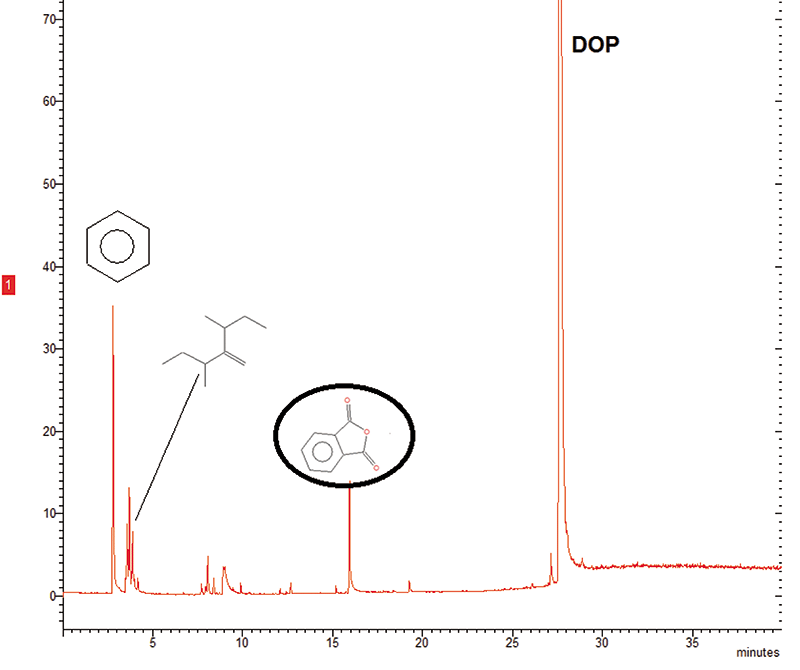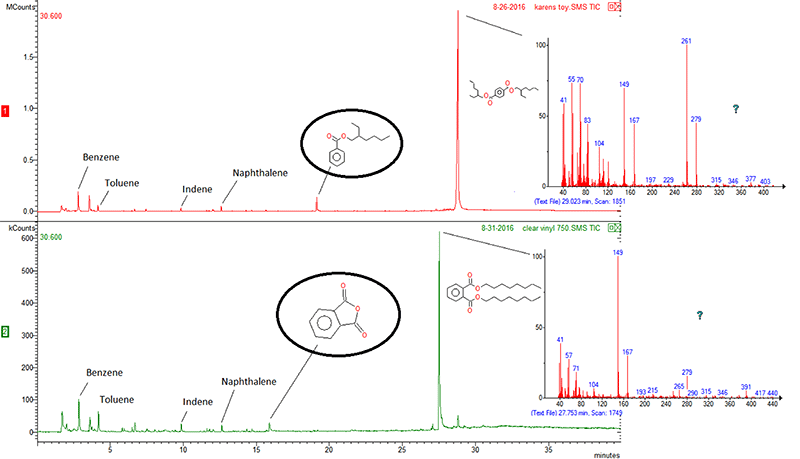Pyrolysis GC–MS Reveals Different Phthalate Isomers in Vinyl Polymers
The Application Notebook
CDS 6000 Series Pyroprobe coupled to a GC–MS is beneficial in phthalate analysis of plastics. This application uncovers intriguing information about phthalates used in vinyl products.
Because pure vinyl is a rigid material, flexible finished vinyl products contain a high amount of phthalate plasticizer. During analytical pyrolysis, these plasticizers are easily thermally desorbed, producing a large peak at the end of the pyrogram, which can be identified using a library search and their unique retention times.
These phthalate plasticizers may also produce unique decomposition products. Electrical tape has a peak for dioctyl phthalate (DOP), and among other things, a decomposition product of DOP, phthalic anhydride (Figure 1).

Figure 1: Electrical tape at 300 °C.
Unique decomposition products can help with phthalate identification. In the next example (Figure 2), a clear vinyl and a green vinyl each contain typical pyrolysis products of PVC, like the aromatics benzene, toluene, and indene. Each vinyl also has large plasticizer peak. Each peak has a similar retention time and similar mass spectra. With such similar mass spectra, a library search could easily mischaracterize them.

Figure 2: Green Vinyl (top), Clear Vinyl (bottom), 700 °C. Phthalate decomposition products circled.
However, each plasticizer has a unique thermal decomposition product, circled in the figure. An ortho-substituted phthalate in the clear vinyl generates phthalic anhydride, but the para-substituted phthalate in the green vinyl generates 2-ethyl hexyl benzoate, helping to simply distinguish between the two.
It is interesting to note that the green vinyl was taken from a child's toy, in which certain phthalate plasticizers are regulated, and there are no regulation requirements for para-substituted phthalates.
The data presented here show clear advantages to identifying phthalates in vinyl materials using pyrolysis GC–MS.

CDS Analytical LLC
465 Limestone Rd, Oxford, PA 19363
tel. (800) 541-6593
Website: www.cdsanalytical.com/pyrolyzer

Determining Enhanced Sensitivity to Odors due to Anxiety-Associated Chemosignals with GC
May 8th 2025Based on their hypothesis that smelling anxiety chemosignals can, like visual anxiety induction, lead to an increase in odor sensitivity, a joint study between the University of Erlangen-Nuremberg (Erlangen, Germany) and the Fraunhofer Institute for Process Engineering and Packaging (Freising, Germany) combined behavioral experiments, odor profile analysis by a trained panel, and instrumental analysis of odorants (gas chromatography-olfactometry) and volatiles (gas chromatography-mass spectrometry).
Investigating 3D-Printable Stationary Phases in Liquid Chromatography
May 7th 20253D printing technology has potential in chromatography, but a major challenge is developing materials with both high porosity and robust mechanical properties. Recently, scientists compared the separation performances of eight different 3D printable stationary phases.
Detecting Hyper-Fast Chromatographic Peaks Using Ion Mobility Spectrometry
May 6th 2025Ion mobility spectrometers can detect trace compounds quickly, though they can face various issues with detecting certain peaks. University of Hannover scientists created a new system for resolving hyper-fast gas chromatography (GC) peaks.

.png&w=3840&q=75)

.png&w=3840&q=75)



.png&w=3840&q=75)



.png&w=3840&q=75)
















